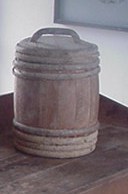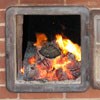
A cookbook printed in 1850 points out that "with good bread the coarsest fare is tolerable; without it, the most luxurious table is not comfortable." Bread was no better, however, than the flour used in making it; and, in 1850, the best test for good flour was to see whether it adhered slightly to the hand, and if pressed in the hand, retained its shape. Dough made from this kind of flour was yellowish white and did not stick to the hands after sufficient kneading. The cookbook warned that there was a great deal of bad flour on the market, which could not be made into nutritious food, and bad flour made a dough resembling putty.
To clean wheat before it was taken to the mill to be ground, two or three bushels were mixed with water and stirred. The water was poured off, and this was repeated until the water was clear and all the chaff removed. Grain could not be allowed to stand in water, since it would swell and be injured. The cleansed wheat was spread on a large cloth in the sun or in a warm spot, stirred occasionally, and dried for a day or two. Newly ground flour that had never been packed was considered superior to barrel flour. Cockle, mustard seed, or bran arising from poor grinding at the mill appeared as dark specks, while blue-colored flour contained dirt. Mealworms found in flour could be sifted from the top few inches of a barrel; and sour flour could be restored by mixing fresh flour of a better grade with it. The latter, however, required judicious handling, and regulations declared it would be "prudent to send occasionally a well qualified man to watch over the process of kneading, to guard against the mixing of cheap but deleterious substances with the dough, as damaged flour."
Contemporary shipping invoices of the 1840s indicate that flour was transported in barrels to the western outposts. Specifications for flour barrels of a later period probably did not differ substantially from those that would have been shipped to Fort Scott. The later barrels were fully head lined and fashioned from strong, tight-fitting staves, They were secured with 12 half-round hickory hoops, each weighing when empty about 23 pounds. The inspection holes were plugged and capped to forestall leakage. The best storage temperature for flour was between 70° and 75° Fahrenheit. Since the ovens of the bakery would have heated the room to a greater temperature than this during the baking process, flour not in immediate use was stored in the Commissary Storehouse. Information for this page was taken from the Historic Furnishing Plan for The Bake House by Sally Johnson Ketchum. |
Last updated: July 26, 2016

